Exhibit 99.3
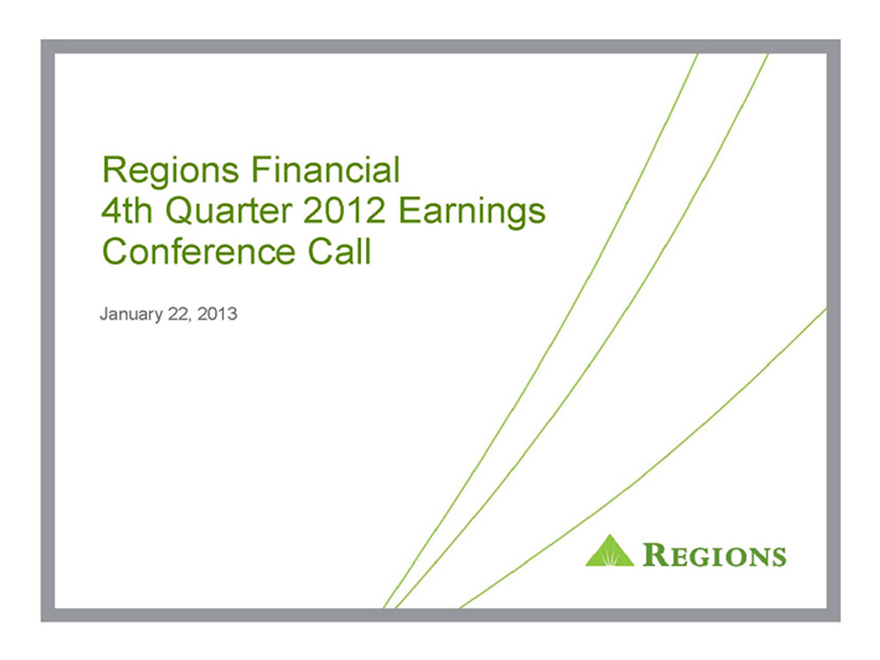
Regions Financial 4th Quarter 2012 Earnings Conference Call January 22, 2013
REGIONS

2012 – A TRANSFORMATIONAL YEAR FOR REGIONS 2012 Financial Highlights Net Income From Continuing Operations $1.1B Available to Common Shareholders EPS From Continuing $0.76 Operations Completed divestiture of Morgan Keegan Issued ~$900 million of common stock Redeemed preferred stock issued to the US Treasury and repurchased warrant Significantly improved asset quality and risk profile Credit ratings improvement Enhanced technology platform Issued preferred stock of $500 million and redeemed $345 million of trust preferred securities “Building a foundation for sustainable growth.”
REGIONS

4Q12 FINANCIAL HIGHLIGHTS ($ in millions, except EPS) 4Q11 3Q12 4Q12 4Q12 vs. 3Q12 4Q12 vs. 4Q11 From Continuing Operations Net Interest Income $ 849 $ 817 $ 818 $ 1 0% $ (31) -4% Adjusted Non-Interest Revenue1 490 521 524 3 1% 34 7% Adjusted Non-Interest Expense1 871 869 849 (20) -2% (22) -3% Adjusted Pre-tax Pre-provision Income (PPI)1 468 469 493 24 5% 25 5% Net Charge-Offs 430 262 180 (82) -31% (250) -58% Loan Loss Reserve Reduction (135) (229) (143) 86 38% (8) -6% Loan Loss Provision 295 33 37 4 12% (258) -87% Preferred Expense 54 - 4 4 NM (50) -93% Net Income / (Loss) Available to Common (135) 312 273 (39) -13% 408 302% Shareholders from Continuing Operations Net Income / (Loss) from Discontinued Operations (467) (11) (12) (1) -9% 455 97% Net Income / (Loss) Available to Common Shareholders $ (602) $ 301 $ 261 $ (40) -13% $ 863 143% Diluted EPS ($0.48) $0.21 $0.18 ($0.03) -14% $0.66 138% Adjusted EPS1 $0.09 $0.22 $0.22 $0.00 NM $0.13 144% Diluted EPS from Continuing Operations ($0.11) $0.22 $0.19 ($0.03) -14% $0.30 273% Diluted EPS from Discontinued Operations ($0.37) ($0.01) ($0.01) $0.00 NM $0.36 97% (1) Non-GAAP– See appendix for GAAP to non-GAAP reconciliation
REGIONS
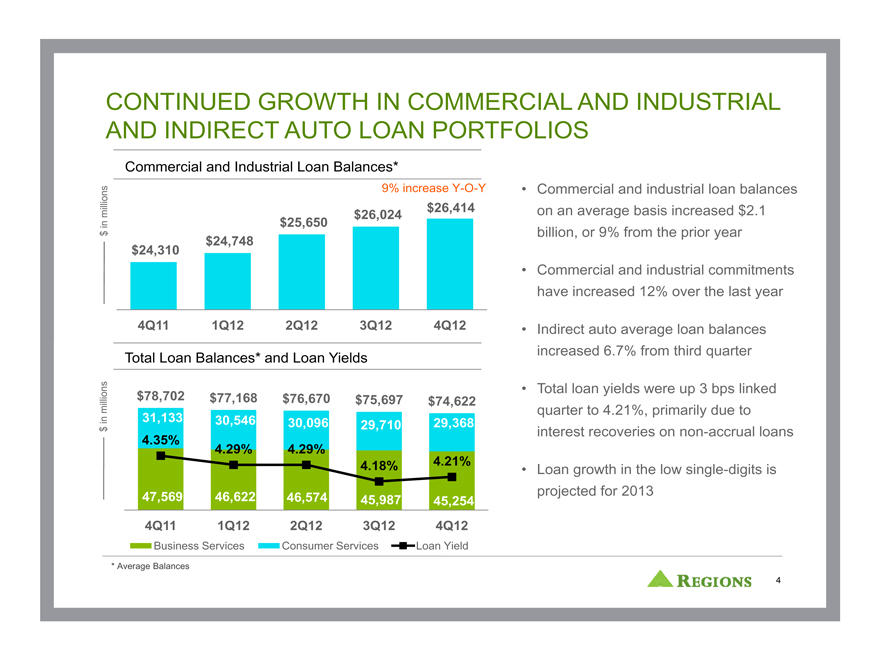
CONTINUED GROWTH IN COMMERCIAL AND INDUSTRIAL AND INDIRECT AUTO LOAN PORTFOLIOS Commercial and Industrial Loan Balances* lions 9% increase Y-O-Y mil $26,414 $26,024 $25,650 in$ $24,748 $24,310 4Q11 1Q12 2Q12 3Q12 4Q12 Total Loan Balances* and Loan Yields millions $78,702 $77,168 $76,670 $75,697 $74,622 31,133 30,546 30,096 29,710 29,368 4.35% 4.29% 4.29% 4.21% 4.18% 47,569 46,622 46,574 45,987 45,254 4Q11 1Q12 2Q12 3Q12 4Q12 Business Services Consumer Services Loan Yield * Average Balances Commercial and industrial loan balances on an average basis increased $2.1 billion, or 9% from the prior year Commercial and industrial commitments have increased 12% over the last year Indirect auto average loan balances increased 6.7% from third quarter Total loan yields were up 3 bps linked quarter to 4.21%, primarily due to interest recoveries on non-accrual loans Loan growth in the low single-digits is projected for 2013
REGIONS
4
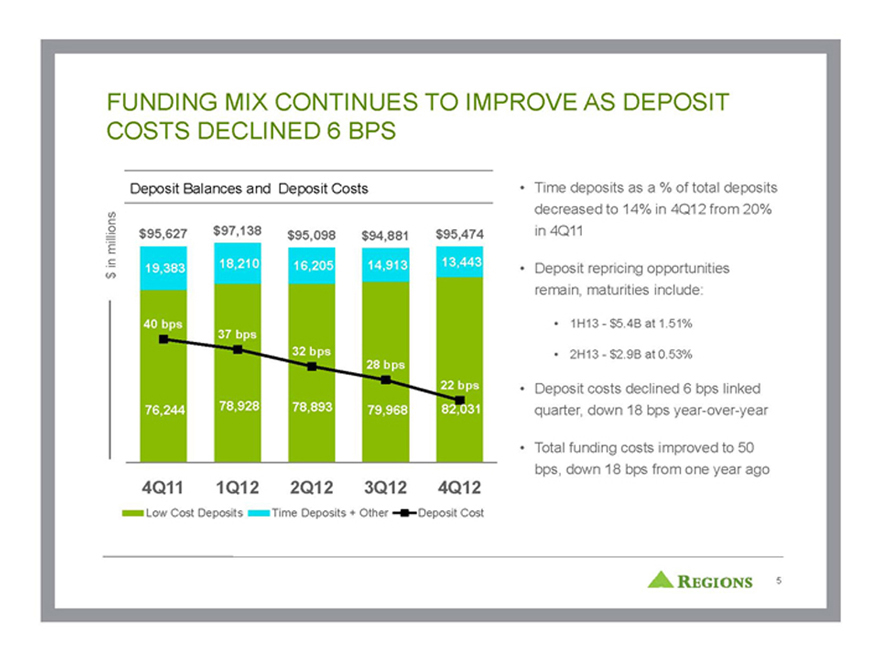
FUNDING MIX CONTINUES TO IMPROVE AS DEPOSIT COSTS DECLINED 6 BPS Deposit Balances and Deposit Costs millions $95,627 $97,138 $95,098 $94,881 $95,474 18,210 16,205 14,913 13,443 19,383 40 bps 37 bps 32 bps 28 bps 22 bps 76,244 78,928 78,893 79,968 82,031 4Q11 1Q12 2Q12 3Q12 4Q12 Low Cost Deposits Time Deposits + Other Deposit Cost Time deposits as a % of total deposits decreased to 14% in 4Q12 from 20% in 4Q11 Deposit repricing opportunities remain, maturities include: 1H13 - $5.4B at 1.51% 2H13 - $2.9B at 0.53% Deposit costs declined 6 bps linked quarter, down 18 bps year-over-year Total funding costs improved to 50 bps, down 18 bps from one year ago
REGIONS
5
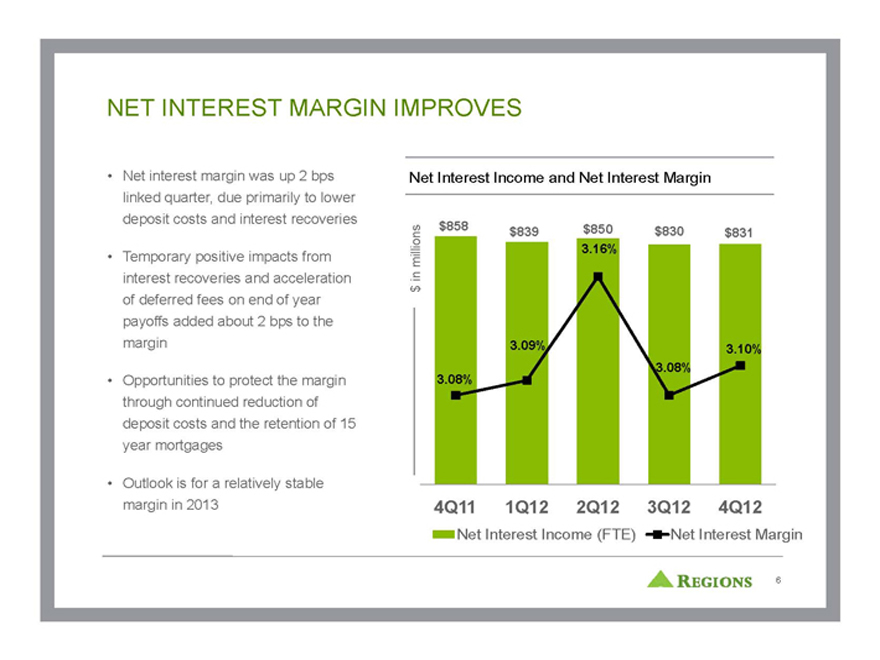
NET INTEREST MARGIN IMPROVES Net interest margin was up 2 bps linked quarter, due primarily to lower deposit costs and interest recoveries Temporary positive impacts from interest recoveries and acceleration of deferred fees on end of year payoffs added about 2 bps to the margin Opportunities to protect the margin through continued reduction of deposit costs and the retention of 15 year mortgages Outlook is for a relatively stable margin in 2013 Net Interest Income and Net Interest Margin $858 $850 $839 $830 $831 millions 3.16% in $ 3.09% 3.10% 3.08% 3.08% 4Q11 1Q12 2Q12 3Q12 4Q12 Net Interest Income (FTE) Net Interest Margin
REGIONS
6
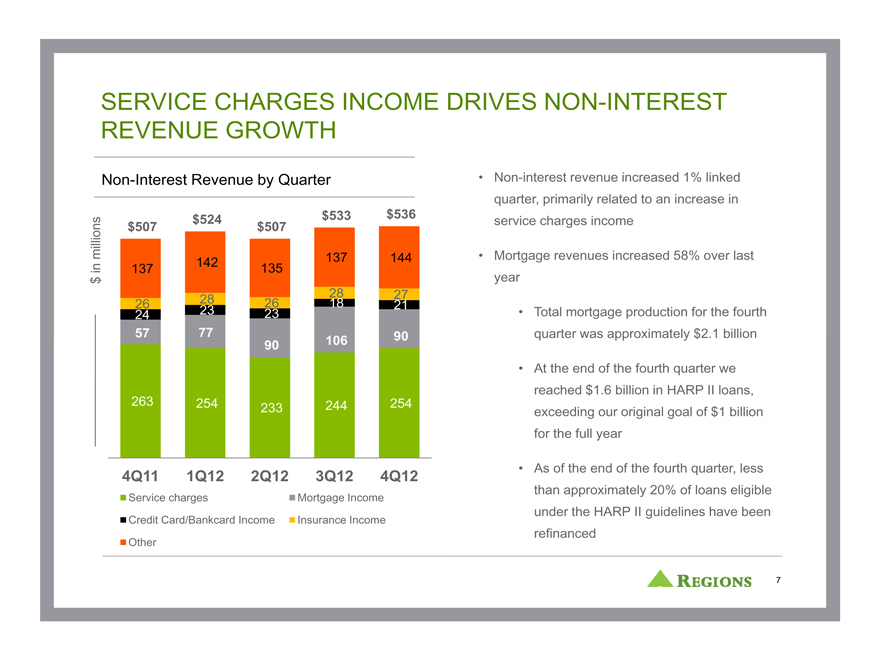
SERVICE CHARGES INCOME DRIVES NON-INTEREST REVENUE GROWTH Non-Interest Revenue by Quarter $524 $533 $536 millions $507 $507 142 137 144 137 135 28 27 26 28 26 18 21 24 23 23 57 77 90 90 106 263 254 244 254 233 4Q11 1Q12 2Q12 3Q12 4Q12 Service charges Mortgage Income Credit Card/Bankcard Income Insurance Income Other Non-interest revenue increased 1% linked quarter, primarily related to an increase in service charges income Mortgage revenues increased 58% over last year Total mortgage production for the fourth quarter was approximately $2.1 billion At the end of the fourth quarter we reached $1.6 billion in HARP II loans, exceeding our original goal of $1 billion for the full year As of the end of the fourth quarter, less than approximately 20% of loans eligible under the HARP II guidelines have been refinanced
REGIONS
7
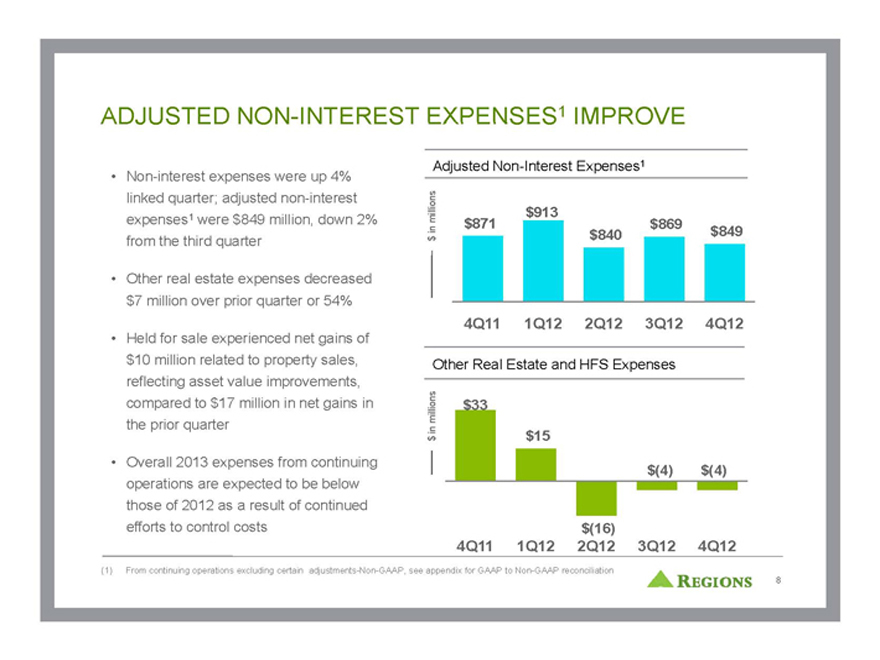
ADJUSTED NON-INTEREST EXPENSES1 IMPROVE Non-interest expenses were up 4% linked quarter; adjusted non-interest expenses1 were $849 million, down 2% from the third quarter Other real estate expenses decreased $7 million over prior quarter or 54% Held for sale experienced net gains of $10 million related to property sales, reflecting asset value improvements, compared to $17 million in net gains in the prior quarter Overall 2013 expenses from continuing operations are expected to be below those of 2012 as a result of continued efforts to control costs Adjusted Non-Interest Expenses1 ons milli $913 in $871 $869 $ $840 $849 4Q11 1Q12 2Q12 3Q12 4Q12 Other Real Estate and HFS Expenses millions $33 in $ $15 $(4) $(4) $(16) 4Q11 1Q12 2Q12 3Q12 4Q12 (1) From continuing operations excluding certain adjustments-Non-GAAP, see appendix for GAAP to Non-GAAP reconciliation
REGIONS
8
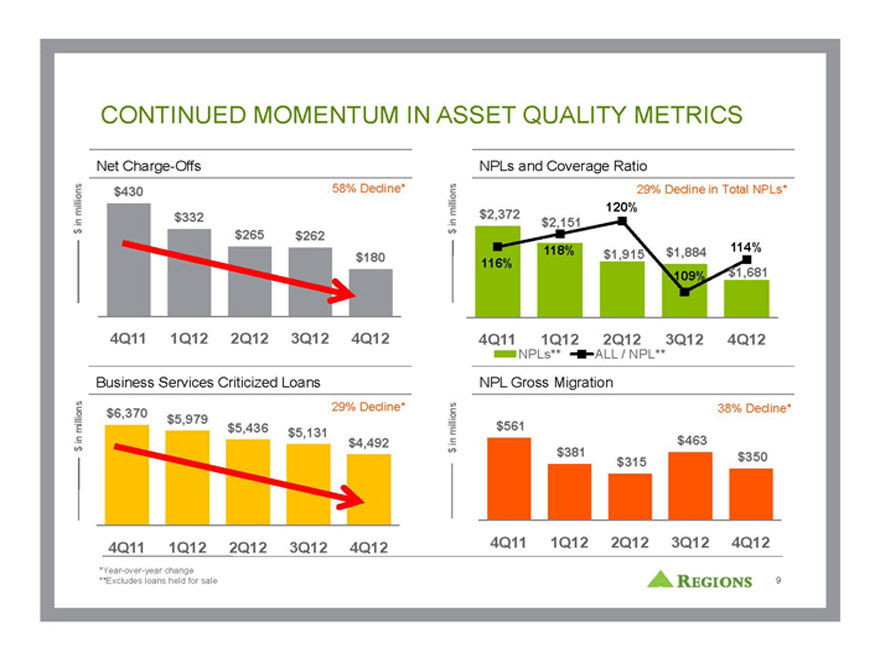
CONTINUED MOMENTUM IN ASSET QUALITY METRICS Net Charge-Offs 58% Decline* millions $430 mi $332 in$ $265 $262 $180 4Q11 1Q12 2Q12 3Q12 4Q12 Business Services Criticized Loans 29% Decline* $6,370 $5,979 millions $5,436 $5,131 $4,492 4Q11 1Q12 2Q12 3Q12 4Q12 NPLs and Coverage Ratio millions 29% Decline in Total NPLs* 120% mi $2,372 $2,151 121% in$ 119% 114% 117% 118% $1,915 $1,884 115% 116% $1,681 113% 109% 111% 109% 107% 105% 4Q11 1Q12 2Q12 3Q12 4Q12 NPLs** ALL / NPL** NPL Gross Migration 38% Decline* millions $561 $463 $381 $315 $350 4Q11 1Q12 2Q12 3Q12 4Q12 *Year-over-year change **Excludes loans held for sale
REGIONS
9
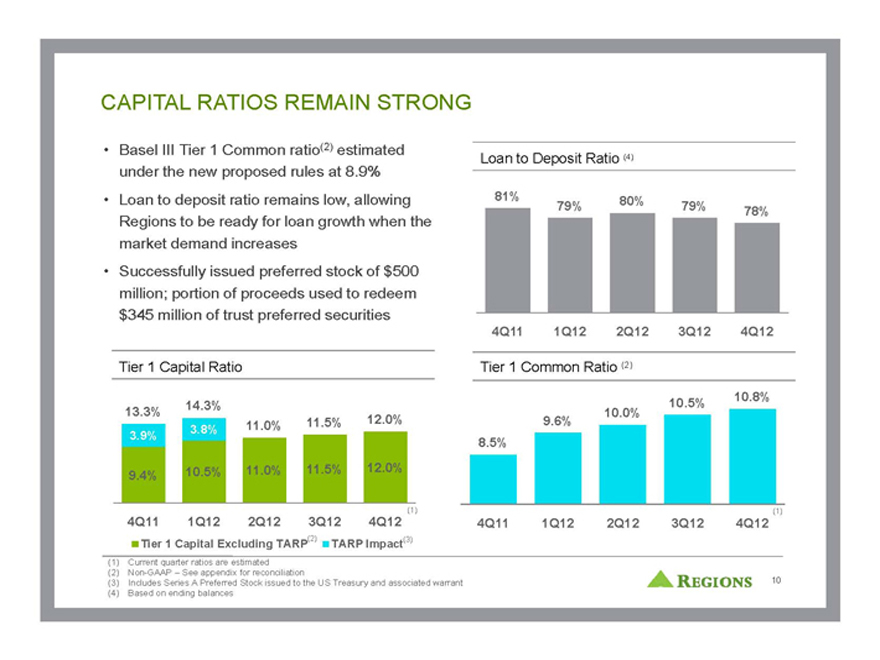
CAPITAL RATIOS REMAIN STRONG Basel III Tier 1 Common ratio(2) estimated under the new proposed rules at 8.9% Loan to deposit ratio remains low, allowing Regions to be ready for loan growth when the market demand increases Successfully issued preferred stock of $500 million; portion of proceeds used to redeem $345 million of trust preferred securities Tier 1 Capital Ratio 14.3% 13.3% 11.5% 12.0% 3.8% 11.0% 3.9% 10.5% 11.0% 11.5% 12.0% 9.4% (1) 4Q11 1Q12 2Q12 3Q12 4Q12 (2) (3) Tier 1 Capital Excluding TARP TARP Impact Loan to Deposit Ratio (4) 81% 80% 79% 79% 78% 4Q11 1Q12 2Q12 3Q12 4Q12 Tier 1 Common Ratio (2) 10.8% 10.5% 10.0% 9.6% 8.5% (1) 4Q11 1Q12 2Q12 3Q12 4Q12 (1) Current quarter ratios are estimated (2) Non-GAAP – See appendix for reconciliation (3) Includes Series A Preferred Stock issued to the US Treasury and associated warrant (4) Based on ending balances
REGIONS
10
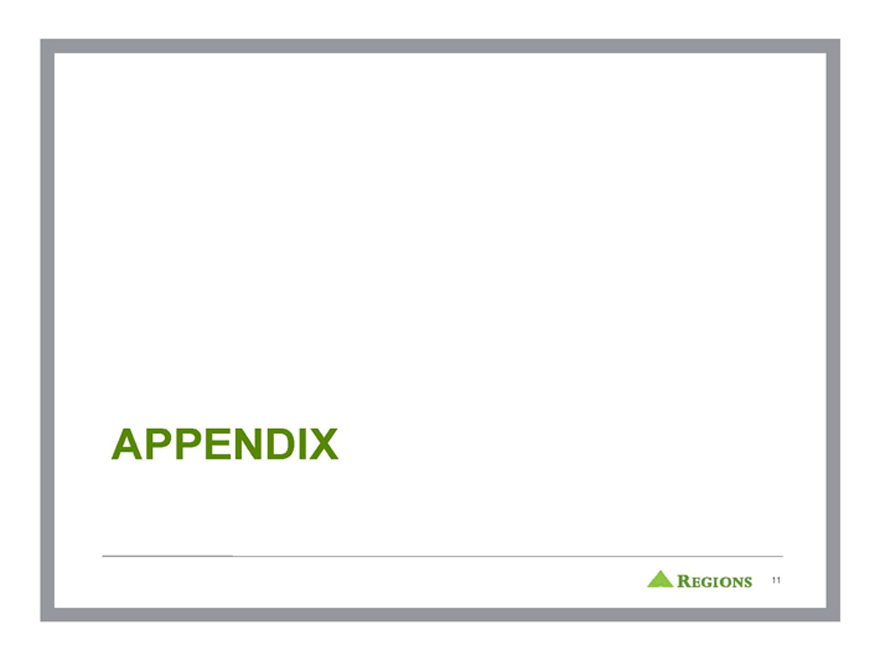
APPENDIX
REGIONS
11
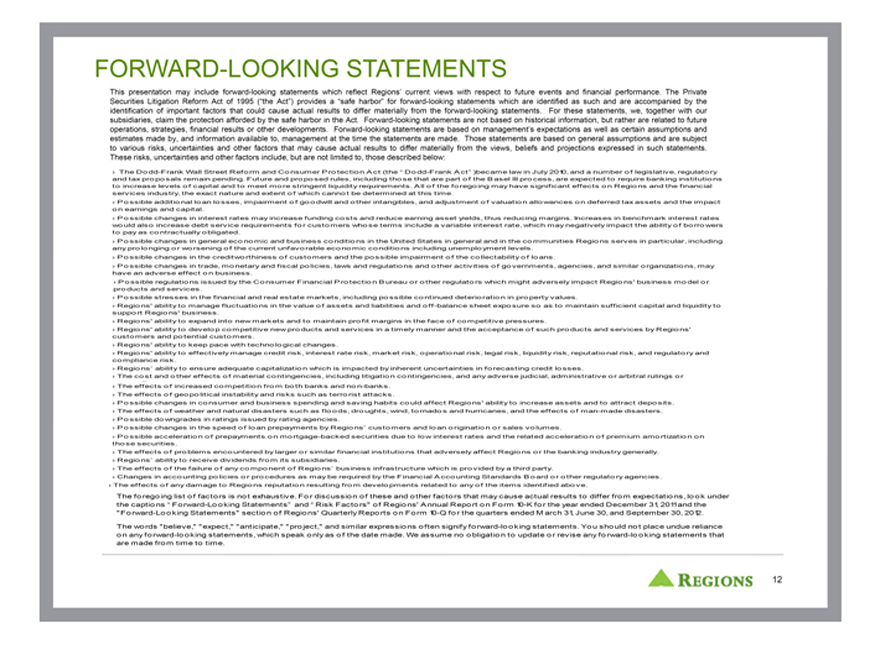
FORWARD-LOOKING STATEMENTS This presentation may include forward-looking statements which reflect Regions’ current views with respect to future events and financial performance. The Private Securities Litigation Reform Act of 1995 (“the Act”) provides a “safe harbor” for forward-looking statements which are identified as such and are accompanied by the identification of important factors that could cause actual results to differ materially from the forward-looking statements. For these statements, we, together with our subsidiaries, claim the protection afforded by the safe harbor in the Act. Forward-looking statements are not based on historical information, but rather are related to future operations, strategies, financial results or other developments. Forward-looking statements are based on management’s expectations as well as certain assumptions and estimates made by, and information available to, management at the time the statements are made. Those statements are based on general assumptions and are subject to various risks, uncertainties and other factors that may cause actual results to differ materially from the views, beliefs and projections expressed in such statements. These risks, uncertainties and other factors include, but are not limited to, those described below: › The Dodd-Frank Wall Street Reform and Consumer Protection Act (the “ Dodd-Frank Act” )became law in July 2010, and a number of legislative, regulatory and tax proposals remain pending. Future and proposed rules, including those that are part of the Basel III process, are expected to require banking institutions to increase levels of capital and to meet more stringent liquidity requirements. All of the foregoing may have significant effects on Regions and the financial services industry, the exact nature and extent of which cannot be determined at this time. › Possible additional loan losses, impairment of goodwill and other intangibles, and adjustment of valuation allowances on deferred tax assets and the impact on earnings and capital. › Possible changes in interest rates may increase funding costs and reduce earning asset yields, thus reducing margins. Increases in benchmark interest rates would also increase debt service requirements for customers whose terms include a variable interest rate, which may negatively impact the ability of borrowers to pay as contractually obligated. › Possible changes in general economic and business conditions in the United States in general and in the communities Regions serves in particular, including any prolonging or worsening of the current unfavorable economic conditions including unemployment levels. › Possible changes in the creditworthiness of customers and the possible impairment of the collectability of loans. › Possible changes in trade, monetary and fiscal policies, laws and regulations and other activities of governments, agencies, and similar organizations, may have an adverse effect on business. › Possible regulations issued by the Consumer Financial Protection Bureau or other regulators which might adversely impact Regions’ business model or products and services. › Possible stresses in the financial and real estate markets, including possible continued deterioration in property values. › Regions’ ability to manage fluctuations in the value of assets and liabilities and off-balance sheet exposure so as to maintain sufficient capital and liquidity to support Regions’ business. › Regions’ ability to expand into new markets and to maintain profit margins in the face of competitive pressures. › Regions’ ability to develop competitive new products and services in a timely manner and the acceptance of such products and services by Regions’ customers and potential customers. › Regions’ ability to keep pace with technological changes. › Regions’ ability to effectively manage credit risk, interest rate risk, market risk, operational risk, legal risk, liquidity risk, reputational risk, and regulatory and compliance risk. › Regions’ ability to ensure adequate capitalization which is impacted by inherent uncertainties in forecasting credit losses. › The cost and other effects of material contingencies, including litigation contingencies, and any adverse judicial, administrative or arbitral rulings or › The effects of increased competition from both banks and non-banks. › The effects of geopolitical instability and risks such as terrorist attacks. › Possible changes in consumer and business spending and saving habits could affect Regions’ ability to increase assets and to attract deposits. › The effects of weather and natural disasters such as floods, droughts, wind, tornados and hurricanes, and the effects of man-made disasters. › Possible downgrades in ratings issued by rating agencies. › Possible changes in the speed of loan prepayments by Regions’ customers and loan origination or sales volumes. › Possible acceleration of prepayments on mortgage-backed securities due to low interest rates and the related acceleration of premium amortization on those securities. › The effects of problems encountered by larger or similar financial institutions that adversely affect Regions or the banking industry generally. › Regions’ ability to receive dividends from its subsidiaries. › The effects of the failure of any component of Regions’ business infrastructure which is provided by a third party. › Changes in accounting policies or procedures as may be required by the Financial Accounting Standards Board or other regulatory agencies. › The effects of any damage to Regions reputation resulting from developments related to any of the items identified above. The foregoing list of factors is not exhaustive. For discussion of these and other factors that may cause actual results to differ from expectations, look under the captions “ Forward-Looking Statements” and “ Risk Factors” of Regions’ Annual Report on Form 10-K for the year ended December 31, 2011 and the “Forward-Looking Statements” section of Regions’ Quarterly Reports on Form 10-Q for the quarters ended March 31, June 30, and September 30, 2012. The words “believe,” “expect,” “anticipate,” “project,” and similar expressions often signify forward-looking statements. You should not place undue reliance on any forward-looking statements, which speak only as of the date made. We assume no obligation to update or revise any forward-looking statements that are made from time to time.
REGIONS
12
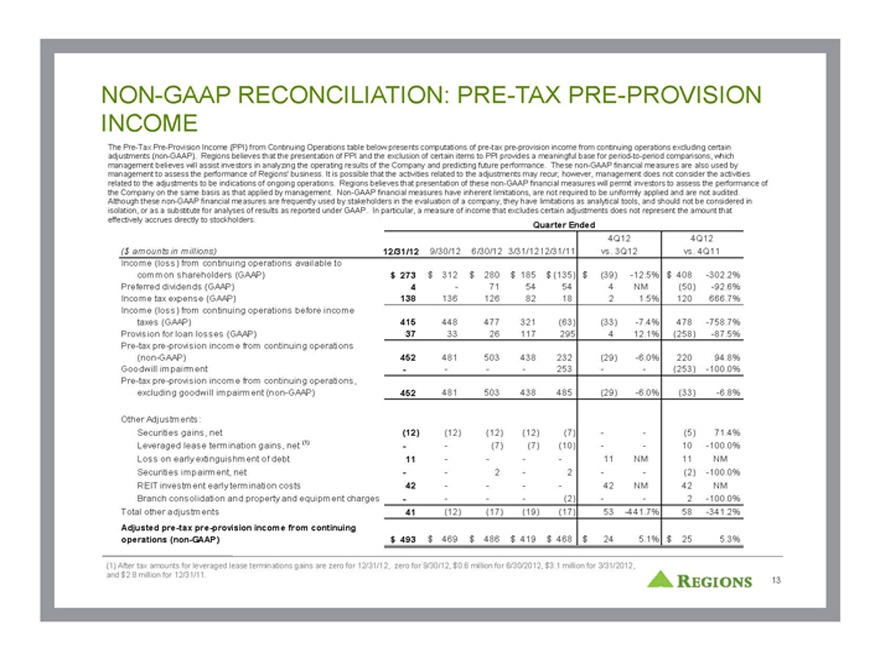
NON-GAAP RECONCILIATION: PRE-TAX PRE-PROVISION INCOME The Pre-Tax Pre-Provision Income (PPI) from Continuing Operations table below presents computations of pre-tax pre-provision income from continuing operations excluding certain adjustments (non-GAAP). Regions believes that the presentation of PPI and the exclusion of certain items to PPI provides a meaningful base for period-to-period comparisons, which management believes will assist investors in analyzing the operating results of the Company and predicting future performance. These non-GAAP financial measures are also used by management to assess the performance of Regions’ business. It is possible that the activities related to the adjustments may recur; however, management does not consider the activities related to the adjustments to be indications of ongoing operations. Regions believes that presentation of these non-GAAP financial measures will permit investors to assess the performance of the Company on the same basis as that applied by management. Non-GAAP financial measures have inherent limitations, are not required to be uniformly applied and are not audited. Although these non-GAAP financial measures are frequently used by stakeholders in the evaluation of a company, they have limitations as analytical tools, and should not be considered in isolation, or as a substitute for analyses of results as reported under GAAP. In particular, a measure of income that excludes certain adjustments does not represent the amount that effectively accrues directly to stockholders. Quarter Ended 4Q12 4Q12 ($ amounts in millions) 12/31/12 9/30/12 6/30/12 3/31/1212/31/11 vs . 3Q12 vs .. 4Q11 Income (loss) from continuing operations available to common shareholders (GAAP) $ 273 $ 312 $ 280 $ 185 $ (135) $ (39) -12.5% $ 408 -302.2% Preferred dividends (GAAP) 4 - 71 54 54 4 NM (50) -92.6% Income tax expense (GAAP) 138 136 126 82 18 2 1.5% 120 666.7% Income (loss) from continuing operations before income taxes (GAAP) 415 448 477 321 (63) (33) -7.4% 478 -758.7% Provision for loan losses (GAAP) 37 33 26 117 295 4 12.1% (258) -87.5% Pre-tax pre-provision income from continuing operations (non-GAAP) 452 481 503 438 232 (29) -6.0% 220 94.8% Goodwill impairment - - - 253 - - (253) -100.0% Pre-tax pre-provision income from continuing operations, excluding goodwill impairment (non-GAAP) 452 481 503 438 485 (29) -6.0% (33) -6.8% Other Adjustments: Securities gains, net (12) (12) (12) (12) (7) - - (5) 71.4% Leveraged lease termination gains, net (1) - - (7) (7) (10) - - 10 -100.0% Loss on early extinguishment of debt 11 - - - 11 NM 11 NM Securities impairment, net - - 2 - 2 - - (2) -100.0% REIT investment early termination costs 42 - - - 42 NM 42 NM Branch consolidation and property and equipment charges - - - (2) - - 2 -100.0% Total other adjustments 41 (12) (17) (19) (17) 53 -441.7% 58 -341.2% Adjusted pre-tax pre-provision income from continuing operations (non-GAAP) $ 493 $ 469 $ 486 $ 419 $ 468 $ 24 5.1% $ 25 5.3% (1) After tax amounts for leveraged lease terminations gains are zero for 12/31/12, zero for 9/30/12, $0.6 million for 6/30/2012, $3.1 million for 3/31/2012, and $2.8 million for 12/31/11.
REGIONS
13
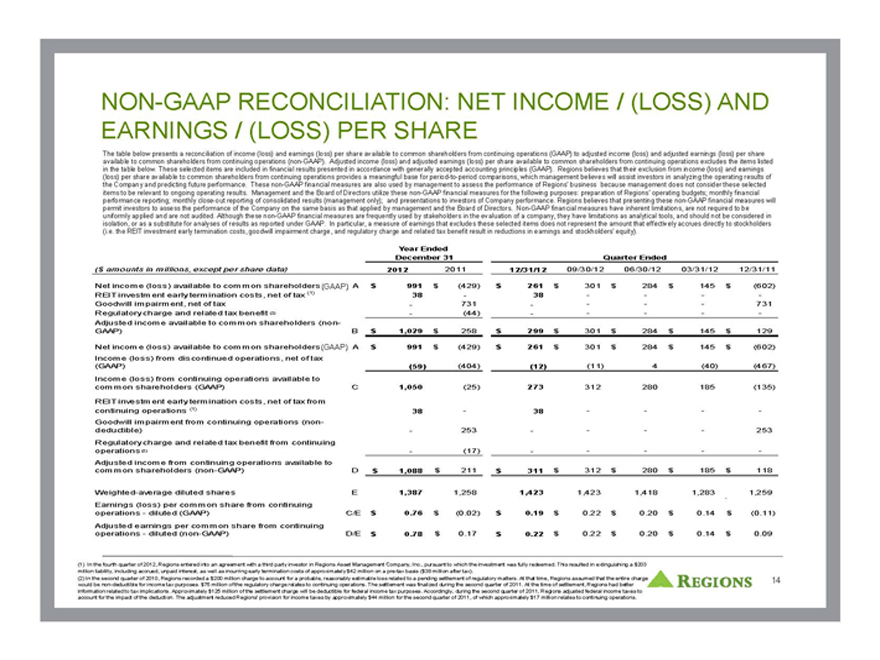
NON-GAAP RECONCILIATION: NET INCOME / (LOSS) AND EARNINGS / (LOSS) PER SHARE The table below presents a reconciliation of income (loss) and earnings (loss) per share available to common shareholders from continuing operations (GAAP) to adjusted income (loss) and adjusted earnings (loss) per share available to common shareholders from continuing operations (non-GAAP). Adjusted income (loss) and adjusted earnings (loss) per share available to common shareholders from continuing operations excludes the items listed in the table below. These selected items are included in financial results presented in accordance with generally accepted accounting principles (GAAP). Regions believes that their exclusion from income (loss) and earnings (loss) per share available to common shareholders from continuing operations provides a meaningful base for period-to-period comparisons, which management believes will assist investors in analyzing the operating results of the Company and predicting future performance. These non-GAAP financial measures are also used by management to assess the performance of Regions’ business because management does not consider these selected items to be relevant to ongoing operating results. Management and the Board of Directors utilize these non-GAAP financial measures for the following purposes: preparation of Regions’ operating budgets; monthly financial performance reporting; monthly close-out reporting of consolidated results (management only); and presentations to investors of Company performance. Regions believes that presenting these non-GAAP financial measures will permit investors to assess the performance of the Company on the same basis as that applied by management and the Board of Directors. Non-GAAP financial measures have inherent limitations, are not required to be uniformly applied and are not audited. Although these non-GAAP financial measures are frequently used by stakeholders in the evaluation of a company, they have limitations as analytical tools, and should not be considered in isolation, or as a substitute for analyses of results as reported under GAAP. In particular, a measure of earnings that excludes these selected items does not represent the amount that effectively accrues directly to stockholders (i.e. the REIT investment early termination costs, goodwill impairment charge, and regulatory charge and related tax benefit result in reductions in earnings and stockholders’ equity). Year Ended December 31 Quarter Ended ($ amounts in millions, except per share data) 2012 2011 12/31/12 09/30/12 06/30/12 03/31/12 12/31/11 Net income (loss) available to common shareholders (GAAP) A $ 991 $ (429) $ 261 $ 301 $ 284 $ 145 $ (602) REIT investment early termination costs, net of tax (1) 38 - 38 - - - Goodwill impairment, net of tax - 731 - - - 731 Regulatory charge and related tax benefit (2) - (44) - - - - Adjusted income available to common shareholders (non- GAAP) B $ 1,029 $ 258 $ 299 $ 301 $ 284 $ 145 $ 129 Net income (loss) available to common shareholders (GAAP) A $ 991 $ (429) $ 261 $ 301 $ 284 $ 145 $ (602) Income (loss) from discontinued operations, net of tax (GAAP) (59) (404) (12) (11) 4 (40) (467) Income (loss) from continuing operations available to common shareholders (GAAP) C 1,050 (25) 273 312 280 185 (135) REIT investment early termination costs, net of tax from continuing operations (1) 38 - 38 - - - Goodwill impairment from continuing operations (non- deductible) - 253 - - - 253 Regulatory charge and related tax benefit from continuing operations (2) - (17) - - - - Adjusted income from continuing operations available to common shareholders (non-GAAP) D $ 1,088 $ 211 $ 311 $ 312 $ 280 $ 185 $ 118 Weighted-average diluted shares E 1,387 1,258 1,423 1,423 1,418 1,283 1,259 ` Earnings (loss) per common share from continuing operations - diluted (GAAP) C/E $ 0.76 $ (0.02) $ 0.19 $ 0.22 $ 0.20 $ 0.14 $ (0.11) Adjusted earnings per common share from continuing operations - diluted (non-GAAP) D/E $ 0.78 $ 0.17 $ 0.22 $ 0.22 $ 0.20 $ 0.14 $ 0.09 (1) In the fourth quarter of 2012, Regions entered into an agreement with a third party investor in Regions Asset Management Company, Inc., pursuant to which the investment was fully redeemed. This resulted in extinguishing a $203 million liability, including accrued, unpaid interest, as well as incurring early termination costs of approximately $42 million on a pre-tax basis ($38 million after tax). (2) In the second quarter of 2010, Regions recorded a $200 million charge to account for a probable, reasonably estimable loss related to a pending settlement of regulatory matters. At that time, Regions assumed that the entire charge would be non-deductible for income tax purposes. $75 million of the regulatory charge relates to continuing operations. The settlement was finalized during the second quarter of 2011. At the time of settlement, Regions had better information related to tax implications. Approximately $125 million of the settlement charge will be deductible for federal income tax purposes. Accordingly, during the second quarter of 2011, Regions adjusted federal income taxes to account for the impact of the deduction. The adjustment reduced Regions’ provision for income taxes by approximately $44 million for the second quarter of 2011, of which approximately $17 million relates to continuing operations.
REGIONS
14
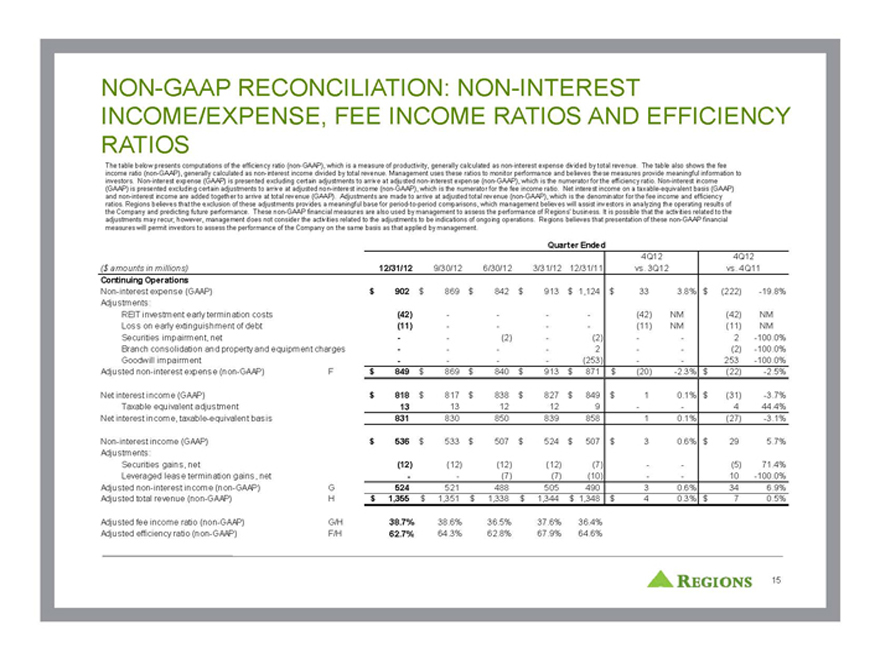
NON-GAAP RECONCILIATION: NON-INTEREST INCOME/EXPENSE, FEE INCOME RATIOS AND EFFICIENCY RATIOS The table below presents computations of the efficiency ratio (non-GAAP), which is a measure of productivity, generally calculated as non-interest expense divided by total revenue. The table also shows the fee income ratio (non-GAAP), generally calculated as non-interest income divided by total revenue. Management uses these ratios to monitor performance and believes these measures provide meaningful information to investors. Non-interest expense (GAAP) is presented excluding certain adjustments to arrive at adjusted non-interest expense (non-GAAP), which is the numerator for the efficiency ratio. Non-interest income (GAAP) is presented excluding certain adjustments to arrive at adjusted non-interest income (non-GAAP), which is the numerator for the fee income ratio. Net interest income on a taxable-equivalent basis (GAAP) and non-interest income are added together to arrive at total revenue (GAAP). Adjustments are made to arrive at adjusted total revenue (non-GAAP), which is the denominator for the fee income and efficiency ratios. Regions believes that the exclusion of these adjustments provides a meaningful base for period-to-period comparisons, which management believes will assist investors in analyzing the operating results of the Company and predicting future performance. These non-GAAP financial measures are also used by management to assess the performance of Regions’ business. It is possible that the activities related to the adjustments may recur; however, management does not consider the activities related to the adjustments to be indications of ongoing operations. Regions believes that presentation of these non-GAAP financial measures will permit investors to assess the performance of the Company on the same basis as that applied by management. Quarter Ended 4Q12 4Q12 ($ amounts in millions) 12/31/12 9/30/12 6/30/12 3/31/12 12/31/11 vs . 3Q12 vs . 4Q11 Continuing Operations Non-interest expense (GAAP) $ 902 $ 869 $ 842 $ 913 $ 1,124 $ 33 3.8% $ (222) -19.8% Adjustments: REIT investment early termination costs (42) - - - (42) NM (42) NM Loss on early extinguishment of debt (11) - - - (11) NM (11) NM Securities impairment, net - - (2) - (2) - - 2 -100.0% Branch consolidation and property and equipment charges - - - 2 - - (2) -100.0% Goodwill impairment - - - (253) - - 253 -100.0% Adjusted non-interest expense (non-GAAP) F $ 849 $ 869 $ 840 $ 913 $ 871 $ (20) -2.3% $ (22) -2.5% Net interest income (GAAP) $ 818 $ 817 $ 838 $ 827 $ 849 $ 1 0.1% $ (31) -3.7% Taxable equivalent adjustment 13 13 12 12 9 - - 4 44.4% Net interest income, taxable-equivalent basis 831 830 850 839 858 1 0.1% (27) -3.1% Non-interest income (GAAP) $ 536 $ 533 $ 507 $ 524 $ 507 $ 3 0.6% $ 29 5.7% Adjustments: Securities gains, net (12) (12) (12) (12) (7) - - (5) 71.4% Leveraged lease termination gains, net - - (7) (7) (10) - - 10 -100.0% Adjusted non-interest income (non-GAAP) G 524 521 488 505 490 3 0.6% 34 6.9% Adjusted total revenue (non-GAAP) H $ 1,355 $ 1,351 $ 1,338 $ 1,344 $ 1,348 $ 4 0.3% $ 7 0.5% Adjusted fee income ratio (non-GAAP) G/H 38.7% 38.6% 36.5% 37.6% 36.4% Adjusted efficiency ratio (non-GAAP) F/H 62.7% 64.3% 62.8% 67.9% 64.6% REGIONS 15
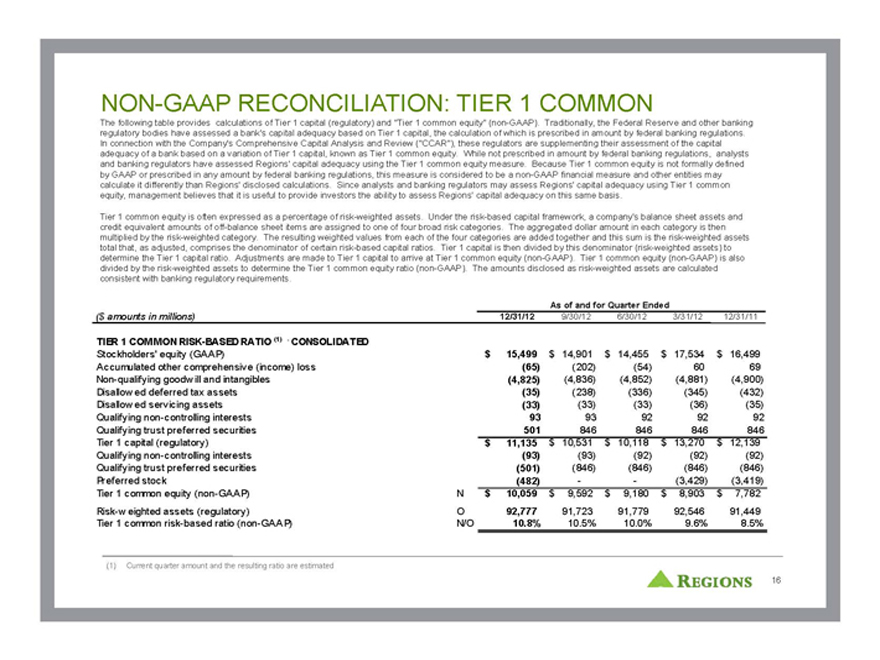
NON-GAAP RECONCILIATION: TIER 1 COMMON The following table provides calculations of Tier 1 capital (regulatory) and “Tier 1 common equity” (non-GAAP). Traditionally, the Federal Reserve and other banking regulatory bodies have assessed a bank’s capital adequacy based on Tier 1 capital, the calculation of which is prescribed in amount by federal banking regulations. In connection with the Company’s Comprehensive Capital Analysis and Review (“CCAR”), these regulators are supplementing their assessment of the capital adequacy of a bank based on a variation of Tier 1 capital, known as Tier 1 common equity. While not prescribed in amount by federal banking regulations, analysts and banking regulators have assessed Regions’ capital adequacy using the Tier 1 common equity measure. Because Tier 1 common equity is not formally defined by GAAP or prescribed in any amount by federal banking regulations, this measure is considered to be a non-GAAP financial measure and other entities may calculate it differently than Regions’ disclosed calculations. Since analysts and banking regulators may assess Regions’ capital adequacy using Tier 1 common equity, management believes that it is useful to provide investors the ability to assess Regions’ capital adequacy on this same basis. Tier 1 common equity is often expressed as a percentage of risk-weighted assets. Under the risk-based capital framework, a company’s balance sheet assets and credit equivalent amounts of off-balance sheet items are assigned to one of four broad risk categories. The aggregated dollar amount in each category is then multiplied by the risk-weighted category. The resulting weighted values from each of the four categories are added together and this sum is the risk-weighted assets total that, as adjusted, comprises the denominator of certain risk-based capital ratios. Tier 1 capital is then divided by this denominator (risk-weighted assets) to determine the Tier 1 capital ratio. Adjustments are made to Tier 1 capital to arrive at Tier 1 common equity (non-GAAP). Tier 1 common equity (non-GAAP) is also divided by the risk-weighted assets to determine the Tier 1 common equity ratio (non-GAAP). The amounts disclosed as risk-weighted assets are calculated consistent with banking regulatory requirements. As of and for Quarter Ended ($ amounts in millions) 12/31/12 9/30/12 6/30/12 3/31/12 12/31/11 TIER 1 COMMON RISK-BASED RATIO (1) - CONSOLIDATED Stockholders’ equity (GAAP) $ 15,499 $ 14,901 $ 14,455 $ 17,534 $ 16,499 Accumulated other comprehensive (income) loss (65) (202) (54) 60 69 Non-qualifying goodwill and intangibles (4,825) (4,836) (4,852) (4,881) (4,900) Disallow ed deferred tax assets (35) (238) (336) (345) (432) Disallow ed servicing assets (33) (33) (33) (36) (35) Qualifying non-controlling interests 93 93 92 92 92 Qualifying trust preferred securities 501 846 846 846 846 Tier 1 capital (regulatory) $ 11,135 $ 10,531 $ 10,118 $ 13,270 $ 12,139 Qualifying non-controlling interests (93) (93) (92) (92) (92) Qualifying trust preferred securities (501) (846) (846) (846) (846) Preferred stock (482) - - (3,429) (3,419) Tier 1 common equity (non-GAAP) N $ 10,059 $ 9,592 $ 9,180 $ 8,903 $ 7,782 Risk-w eighted assets (regulatory) O 92,777 91,723 91,779 92,546 91,449 Tier 1 common risk-based ratio (non-GAAP) N/O 10.8% 10.5% 10.0% 9.6% 8.5% (1) Current quarter amount and the resulting ratio are estimated
REGIONS
16
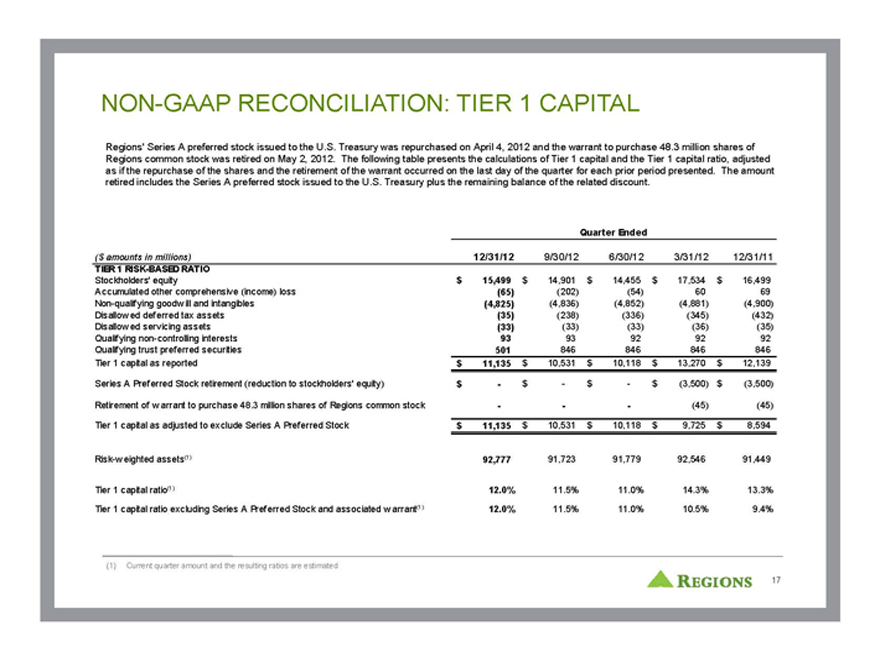
NON-GAAP RECONCILIATION: TIER 1 CAPITAL Regions’ Series A preferred stock issued to the U.S. Treasury was repurchased on April 4, 2012 and the warrant to purchase 48.3 million shares of Regions common stock was retired on May 2, 2012. The following table presents the calculations of Tier 1 capital and the Tier 1 capital ratio, adjusted as if the repurchase of the shares and the retirement of the warrant occurred on the last day of the quarter for each prior period presented. The amount retired includes the Series A preferred stock issued to the U.S. Treasury plus the remaining balance of the related discount. Quarter Ended ($ amounts in millions) 12/31/12 9/30/12 6/30/12 3/31/12 12/31/11 TIER 1 RISK-BASED RATIO Stockholders’ equity $ 15,499 $ 14,901 $ 14,455 $ 17,534 $ 16,499 Accumulated other comprehensive (income) loss (65) (202) (54) 60 69 Non-qualifying goodwill and intangibles (4,825) (4,836) (4,852) (4,881) (4,900) Disallow ed deferred tax assets (35) (238) (336) (345) (432) Disallow ed servicing assets (33) (33) (33) (36) (35) Qualifying non-controlling interests 93 93 92 92 92 Qualifying trust preferred securities 501 846 846 846 846 Tier 1 capital as reported $ 11,135 $ 10,531 $ 10,118 $ 13,270 $ 12,139 Series A Preferred Stock retirement (reduction to stockholders’ equity) $ - $ - $ - $ (3,500) $ (3,500) Retirement of warrant to purchase 48.3 million shares of Regions common stock - - (45) (45) Tier 1 capital as adjusted to exclude Series A Preferred Stock $ 11,135 $ 10,531 $ 10,118 $ 9,725 $ 8,594 Risk-weighted assets(1) 92,777 91,723 91,779 92,546 91,449 Tier 1 capital ratio(1) 12.0% 11.5% 11.0% 14.3% 13.3% Tier 1 capital ratio excluding Series A Preferred Stock and associated warrant(1) 12.0% 11.5% 11.0% 10.5% 9.4% (1) Current quarter amount and the resulting ratios are estimated
REGIONS
17
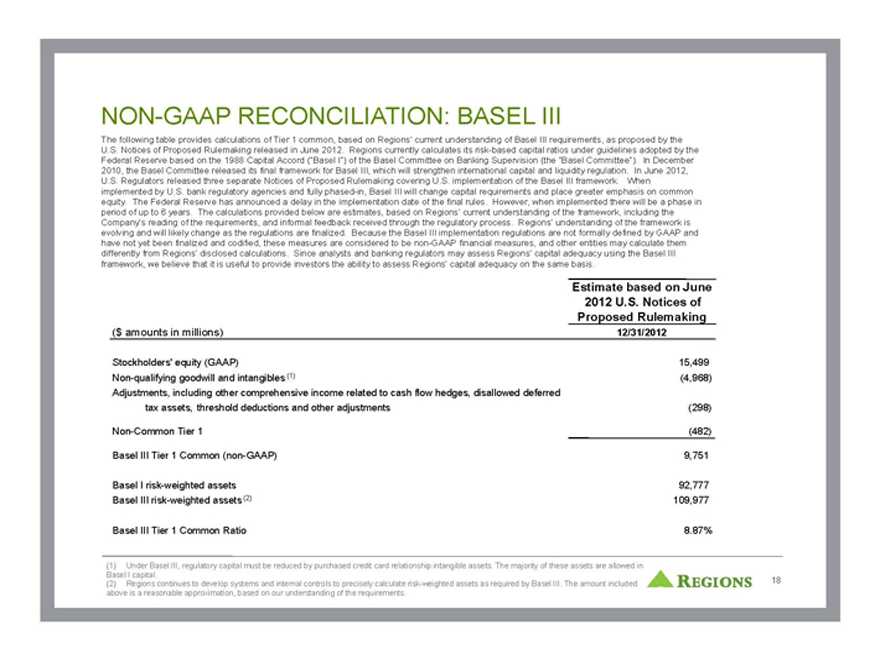
NON-GAAP RECONCILIATION: BASEL III The following table provides calculations of Tier 1 common, based on Regions’ current understanding of Basel III requirements, as proposed by the U.S. Notices of Proposed Rulemaking released in June 2012. Regions currently calculates its risk-based capital ratios under guidelines adopted by the Federal Reserve based on the 1988 Capital Accord (“Basel I”) of the Basel Committee on Banking Supervision (the “Basel Committee”). In December 2010, the Basel Committee released its final framework for Basel III, which will strengthen international capital and liquidity regulation. In June 2012, U.S. Regulators released three separate Notices of Proposed Rulemaking covering U.S. implementation of the Basel III framework. When implemented by U.S. bank regulatory agencies and fully phased-in, Basel III will change capital requirements and place greater emphasis on common equity. The Federal Reserve has announced a delay in the implementation date of the final rules. However, when implemented there will be a phase in period of up to 6 years. The calculations provided below are estimates, based on Regions’ current understanding of the framework, including the Company’s reading of the requirements, and informal feedback received through the regulatory process. Regions’ understanding of the framework is evolving and will likely change as the regulations are finalized. Because the Basel III implementation regulations are not formally defined by GAAP and have not yet been finalized and codified, these measures are considered to be non-GAAP financial measures, and other entities may calculate them differently from Regions’ disclosed calculations. Since analysts and banking regulators may assess Regions’ capital adequacy using the Basel III framework, we believe that it is useful to provide investors the ability to assess Regions’ capital adequacy on the same basis. Estimate based on June 2012 U.S. Notices of Proposed Rulemaking ($ amounts in millions) 12/31/2012 Stockholders’ equity (GAAP) 15,499 Non-qualifying goodwill and intangibles (1) (4,968) Adjustments, including other comprehensive income related to cash flow hedges, disallowed deferred tax assets, threshold deductions and other adjustments (298) Non-Common Tier 1 (482) Basel III Tier 1 Common (non-GAAP) 9,751 Basel I risk-weighted assets 92,777 Basel III risk-weighted assets (2) 109,977 Basel III Tier 1 Common Ratio 8.87% (1) Under Basel III, regulatory capital must be reduced by purchased credit card relationship intangible assets. The majority of these assets are allowed in Basel I capital. (2) Regions continues to develop systems and internal controls to precisely calculate risk-weighted assets as required by Basel III. The amount included above is a reasonable approximation, based on our understanding of the requirements.
REGIONS
18
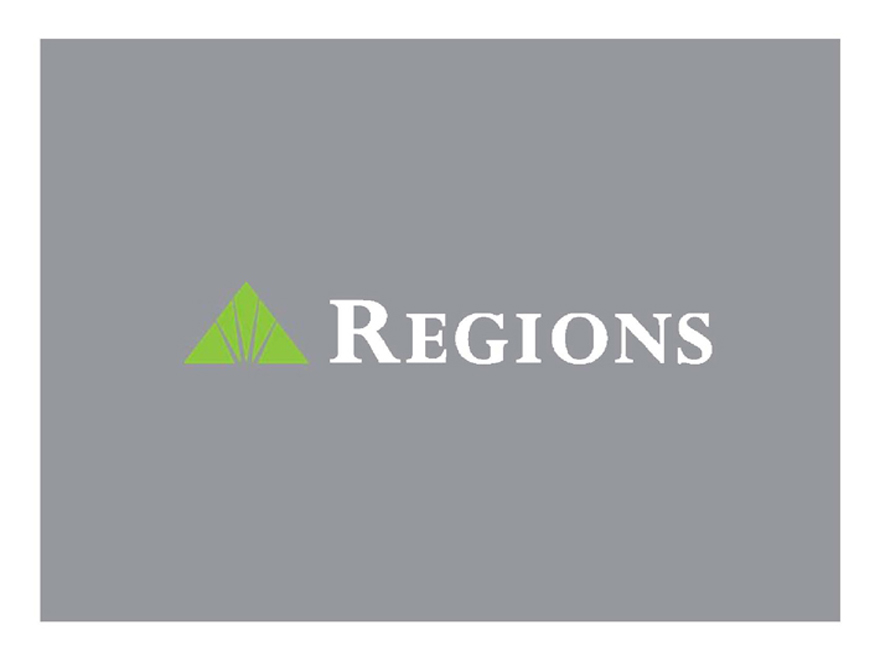
REGIONS


















